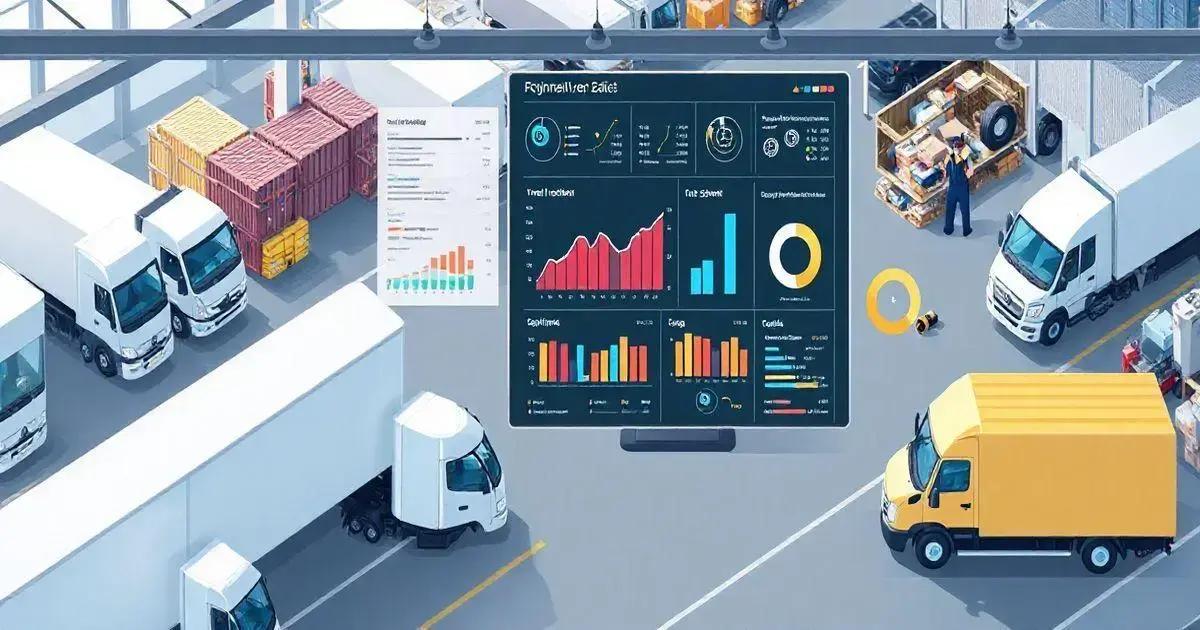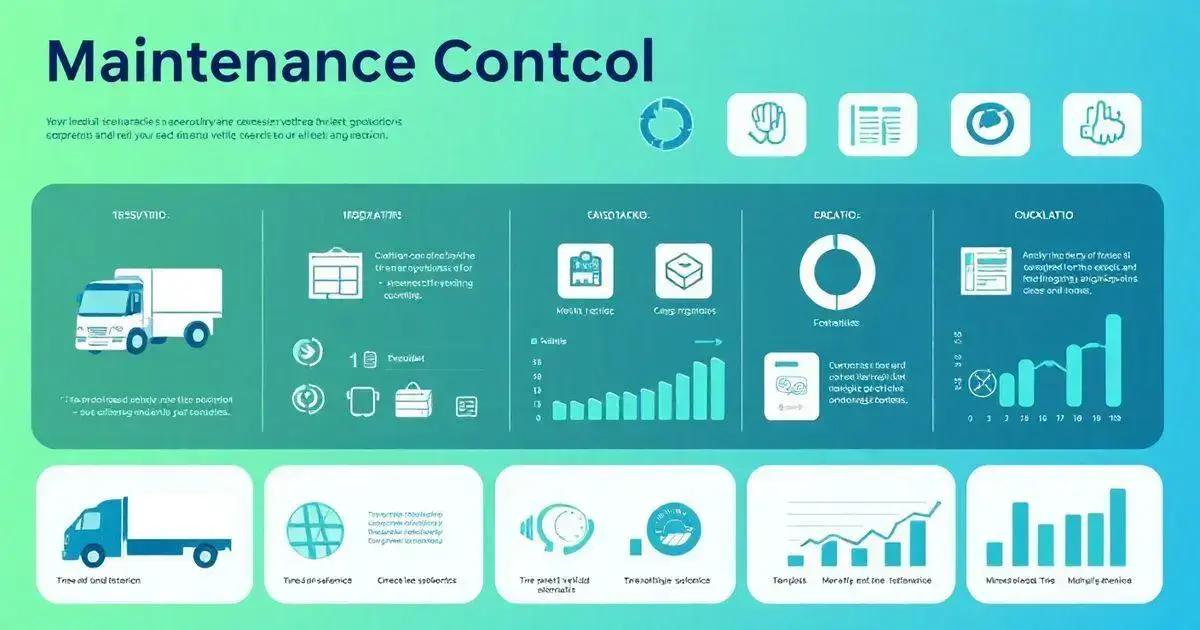Maximize Your Efficiency with the Fleet Control Worksheet 7.0 Leave a comment
The Fleet Control Worksheet 7.0 is a comprehensive fleet management tool that enhances operational efficiency through features like initial dashboards for tracking vehicle usage, travel control management for trips and expenses, tire control for maintenance scheduling, and a document management system for compliance. Its user-friendly design includes customizable dashboards and automated alerts, making it an essential resource for fleet managers to improve safety and manage costs effectively.
If you’re in logistics or manage a fleet of vehicles, you know how crucial it is to keep everything running smoothly. The Fleet Control Worksheet 7.0 is designed to streamline your operations, making it easier to track travel, cargo, tire management, and maintenance. This comprehensive tool is packed with features to help you optimize every aspect of your fleet management.
Initial Dashboards
Initial Dashboards
The Fleet Control Worksheet 7.0 comes equipped with various initial dashboards that provide you with critical insights at a glance. These dashboards are essential for monitoring your fleet’s performance efficiently. Here are the key features:
- KM by Driver: Track how many kilometers each driver has traveled, allowing for performance assessments.
- KM per Vehicle: Understand each vehicle’s usage, helping you identify which vehicles are over or under-utilized.
- KM per Liter: Monitor fuel efficiency by calculating kilometers driven per liter of fuel consumed, essential for cost management.
- KM per Trip: Analyze trip distances to ensure optimal routing and resource allocation.
- Average Consumption per Vehicle: Keep an eye on fuel consumption trends across different vehicles to spot inefficiencies.
- Average Consumption per Driver: Evaluate each driver’s fuel usage patterns to promote best practices and identify training opportunities.
- Total General, Preventive and Corrective Maintenance: Easily view all maintenance activities, categorized into preventive and corrective, for better planning and budget management.
- Maintenance Cost Average: Track average maintenance costs to forecast future expenses and budget effectively.
- Total Cost of Mechanical and Electrical Maintenance: Keep a comprehensive record of all mechanical and electrical maintenance expenses to manage service contracts and warranties better.
- Total Tire Maintenance Cost: Calculate and manage all costs associated with tire maintenance, an often-overlooked expense in fleet management.
- Total Lubricant Cost: Track lubricant expenses to ensure that your vehicles are adequately maintained without overspending.
- Average Cost of Mechanical and Electrical Maintenance: Gain insights into the average costs involved in mechanical and electrical services to streamline budgeting.
- Average Tire Maintenance Cost: Understand average tire-related costs to optimize purchasing and maintenance strategies.
- Average Cost with Lubricants: Keep a record of lubricant expenses over time to predict future requirements and plan purchases accordingly.
- Vehicles in Transit: Have real-time visibility of which vehicles are currently in transit, helping you manage logistics on the fly.
- Tires in Transit: Monitor the status of tires that are in use or being transferred, crucial for inventory management.
- Delayed Vehicle Documents: Track any vehicle document delays to ensure compliance and avoid legal issues.
- Delayed Driver Documents: Manage driver documentation efficiently to keep your team compliant and operational.
- Delayed Preventive Maintenance: Identify overdue maintenance activities to ensure your fleet is always in optimal condition.
- Total Cost Versus Shipping: Evaluate the overall cost of operations against shipping costs to determine profitability.
- Fuel, Maintenance, and Other Costs: Have a holistic view of all costs associated with fleet operations for comprehensive financial planning.
These initial dashboards are not just a collection of data; they are your operational command center—providing the insights needed to make informed decisions and drive efficiency in your fleet management.

Travel Control Management
Effective travel control is vital for maintaining the efficiency and safety of your fleet. The Fleet Control Worksheet 7.0 offers a comprehensive framework for managing all aspects of travel related to your fleet operations. Here’s how you can optimize your travel management:
Travel Control Management
- Cargo Control Linked to Trips: This feature allows you to associate specific cargo loads with their respective trips, ensuring accurate tracking of what is being transported at any given time. It helps in maintaining accountability and enhances traceability.
- Vehicle Control: Monitor the condition and availability of vehicles assigned to various trips. This oversight allows you to manage resources better, ensuring that the right vehicles are used for the right jobs.
- Driver Control: Keep track of drivers assigned to specific trips. This not only helps in performance monitoring but also aids in maintaining compliance with driving regulations and safety protocols.
- Supply Control: Manage the supplies needed for each trip seamlessly. This includes tracking fuel, lubricants, and any other essential items required for your vehicles, ensuring that your fleet is always well-prepared for journeys.
- Control of All Travel Expenses: The worksheet enables you to log all expenses related to travel, including fuel costs, tolls, and maintenance incurred during trips. This data is crucial for accurate budgeting and financial forecasting.
By effectively managing travel through the Fleet Control Worksheet, you can improve logistical operations, enhance driver accountability, and ultimately reduce operational costs. This holistic approach to travel control ensures that every trip is optimized for efficiency and productivity.
Tire Control Features
Managing tires effectively is a crucial aspect of fleet operations, as it directly impacts safety, costs, and vehicle performance. The Fleet Control Worksheet 7.0 provides robust tire control features that help you keep your fleet running smoothly. Here are the key components:
Tire Control Features
- Identification for Each Tire: Assign unique identifiers to every tire in your fleet, allowing for easy tracking and management. This helps in maintaining accurate records for each tire’s condition and usage history.
- Tire Change Schedule by KM: Set up a proactive tire replacement schedule based on kilometers driven. This feature helps you adhere to best practices for tire maintenance, reducing the risk of blowouts and enhancing safety.
- Signal of How Much KM is Left to Change the Tire: Get notified about the remaining kilometers until tires need to be replaced. This foresight allows you to plan for changes before they become critical, minimizing downtime.
- Status per Action: Track the status of each tire through various actions such as allocation to a vehicle, removal, scrapping, or maintenance. This feature provides clarity on tire usage and helps optimize inventory management.
By implementing these tire control features, you ensure better safety and efficiency in your fleet operations. Keeping a detailed log of tire conditions and maintenance will not only extend the lifespan of your tires but also enhance the overall performance of your vehicles.

Maintenance Control Overview
Maintenance control is essential for ensuring that your fleet operates at peak performance and safety. The Fleet Control Worksheet 7.0 offers a comprehensive maintenance management system designed to streamline and enhance your fleet’s upkeep. Here’s an overview of its key features:
Key Features
- Corrective and Preventive Maintenance Type: Easily categorize your maintenance activities into corrective (repairs) and preventive (scheduled upkeep) tasks. This distinction helps prioritize actions and allocate resources efficiently, ensuring that your fleet remains in optimal condition.
- Maintenance by Vehicle: Track maintenance records by each vehicle in your fleet. This allows you to monitor which vehicles require services and helps avoid neglecting any unit, ultimately promoting a safer driving experience.
- Maintenance by Mechanical and Electrical Type, Tire and Lubricants: Manage maintenance activities based on specific types of work, such as mechanical, electrical, tire services, and lubricant replacements. This detailed approach ensures all aspects of vehicle performance are regularly evaluated and maintained.
- Maintenance Cost: Keep track of all costs associated with maintenance activities. This feature provides valuable insights into expenditure, allowing for more accurate budgeting and financial planning.
- Preventive Maintenance Schedule: Create and manage schedules for routine maintenance tasks based on time or vehicle usage. Regular preventative measures can significantly reduce the likelihood of breakdowns, prolonging the life of your fleet.
- Preventive Maintenance Signal: Receive alerts for upcoming preventive maintenance tasks. This proactive approach ensures that maintenance is performed on time, preventing last-minute rushes and operational disruptions.
- Status by: Keep track of maintenance tasks by their status—scheduled, accomplished, or delayed. This transparency helps in ensuring that all necessary maintenance is completed on schedule, enhancing accountability and performance.
By utilizing these maintenance control features, you can significantly improve the reliability and safety of your fleet. A well-maintained fleet not only saves on costs in the long run but also enhances operational efficiency and driver satisfaction.
Document Management System
In fleet management, maintaining thorough documentation is as crucial as managing the vehicles themselves.
Document Management System
The Fleet Control Worksheet 7.0 features a robust Document Management System designed to streamline the organization and accessibility of necessary documents. Here’s how it works:
- Driver Document Control: Keep track of all essential documents for each driver, including licenses, certifications, and training records. This feature ensures you can verify compliance and qualifications seamlessly, reducing the risk of legal issues.
- Vehicle Document Control: Manage all documents related to each vehicle in your fleet, such as registration papers, insurance, and maintenance records. Having this information readily available helps streamline audits and inspections, ensuring that every vehicle meets regulatory standards.
This Document Management System not only enhances organization but also promotes accountability within your fleet operations. By ensuring all documents are up to date and easily accessible, you can minimize risks and maintain compliance effortlessly.

User-Friendly Features
The Fleet Control Worksheet 7.0 is designed with user experience in mind, ensuring that fleet managers can navigate and utilize the tool effectively without a steep learning curve. Here are some of the standout user-friendly features:
User-Friendly Features
- Intuitive Interface: The worksheet is laid out in a clear and logical manner, making it easy for users to find the information they need quickly. This organization reduces the time spent searching for specific data, enhancing overall productivity.
- Customizable Dashboards: Users can tailor their dashboards to highlight the metrics that matter most to them. This flexibility allows fleet managers to focus on specific aspects of fleet performance that align with their operational goals.
- Automated Alerts and Reminders: The system includes automated notifications for maintenance schedules, document renewals, and other critical tasks, ensuring that nothing slips through the cracks. This feature helps in maintaining compliance and operational efficiency.
- Comprehensive Help Section: A dedicated help section provides users with detailed guidance on how to utilize various features of the worksheet. This resource is invaluable for new users and serves as a quick reference for more experienced users as well.
- Data Visualization: The worksheet includes graphs and charts that visually represent key performance indicators, making it easier to analyze trends and make informed decisions regarding fleet operations.
- Mobile-Friendly Design: The worksheet is optimized for use on multiple devices, allowing users to access critical information while on the go. This feature is particularly beneficial for managers who need to make decisions while out in the field.
By incorporating these user-friendly features, the Fleet Control Worksheet 7.0 ensures that all users, regardless of their technical background, can effectively monitor and manage their fleet with confidence and ease.
Conclusion
The Fleet Control Worksheet 7.0 stands out as an essential tool for anyone involved in fleet management.
With its comprehensive features for travel control, tire management, maintenance oversight, and document management, this worksheet provides fleet managers with the tools they need to operate efficiently and effectively.
User-friendly features, such as customizable dashboards and automated alerts, enhance the overall experience, making it accessible for users with varying levels of technical expertise.
By leveraging the capabilities of this worksheet, fleet managers can ensure their operations run smoothly, minimize costs, and maintain high standards of safety and compliance.
Investing in the Fleet Control Worksheet 7.0 not only streamlines processes but also empowers managers to make informed decisions that drive success in fleet operations.
Frequently Asked Questions about Fleet Control Worksheet 7.0
What is the Fleet Control Worksheet 7.0?
The Fleet Control Worksheet 7.0 is a comprehensive tool designed for managing various aspects of fleet operations, including travel control, maintenance, tire management, and document tracking.
How can the worksheet help with maintenance management?
The worksheet provides features for tracking preventive and corrective maintenance, scheduling maintenance tasks, and logging maintenance costs, helping ensure that vehicles are kept in optimal condition.
Can I customize my dashboards within the worksheet?
Yes, the Fleet Control Worksheet 7.0 allows you to customize dashboards to display the metrics that are most relevant to your fleet management needs.
Is the Fleet Control Worksheet user-friendly?
Absolutely! The worksheet is designed with an intuitive interface, making it accessible for users of all technical backgrounds. It also includes a comprehensive help section.
Will I receive alerts for important tasks?
Yes, the worksheet includes automated alerts and reminders for maintenance schedules and document renewals, ensuring you never miss important deadlines.
Is the worksheet accessible on mobile devices?
Yes! The Fleet Control Worksheet 7.0 is optimized for mobile use, allowing fleet managers to access critical information on the go.

